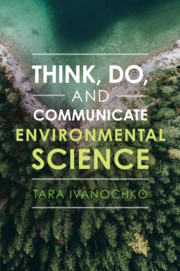Book contents
- Think, Do, and Communicate Environmental Science
- Think, Do, and Communicate Environmental Science
- Copyright page
- Contents
- Prologue
- Acknowledgements
- Introduction
- Part I Thinking Environmental Science
- Chapter 1
- Chapter 2
- Chapter 3
- Chapter 4
- Part II Doing Environmental Science
- Part III Communicating Environmental Science
- Epilogue
- Appendix: Working in Excel
- Glossary
- Index
- References
Chapter 2
from Part I - Thinking Environmental Science
Published online by Cambridge University Press: 23 April 2021
- Think, Do, and Communicate Environmental Science
- Think, Do, and Communicate Environmental Science
- Copyright page
- Contents
- Prologue
- Acknowledgements
- Introduction
- Part I Thinking Environmental Science
- Chapter 1
- Chapter 2
- Chapter 3
- Chapter 4
- Part II Doing Environmental Science
- Part III Communicating Environmental Science
- Epilogue
- Appendix: Working in Excel
- Glossary
- Index
- References
Summary
Imagine that you have found a new planet and you are able to measure the temperature of the planet at various locations on the surface of the planet: 10 in the northern half of the planet and 10 in the southern half of the planet. The northern data and the southern data show opposite patterns. You have now been asked to characterize the temperature of the planet over one year.
- Type
- Chapter
- Information
- Think, Do, and Communicate Environmental Science , pp. 21 - 33Publisher: Cambridge University PressPrint publication year: 2021

